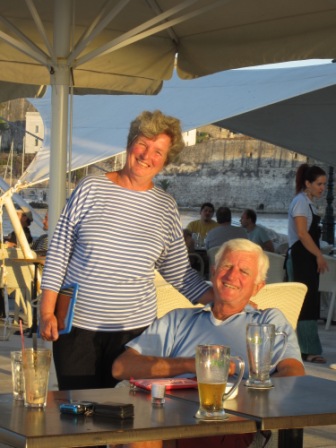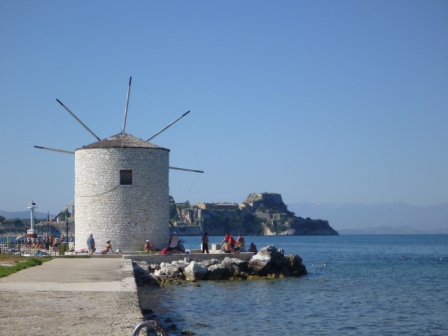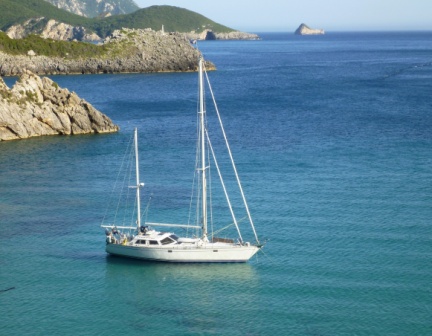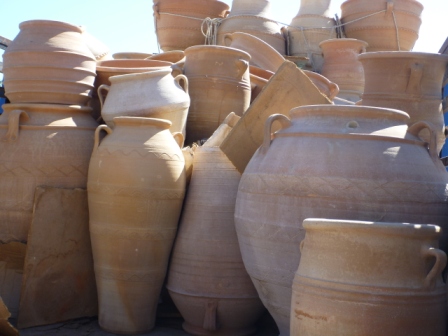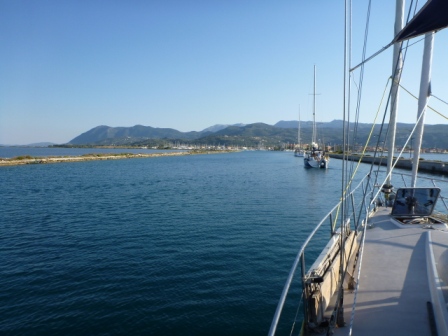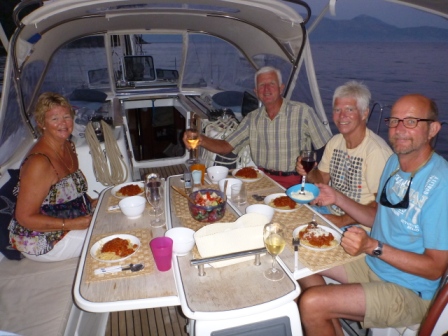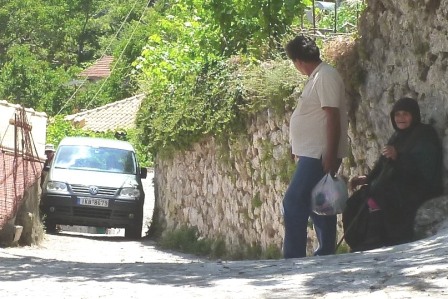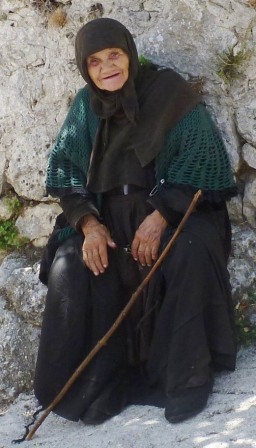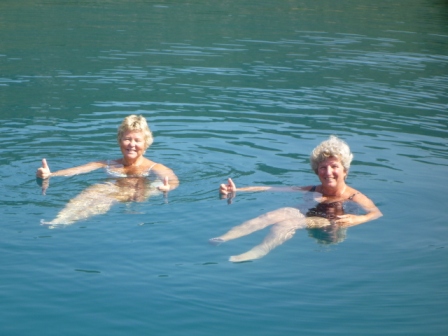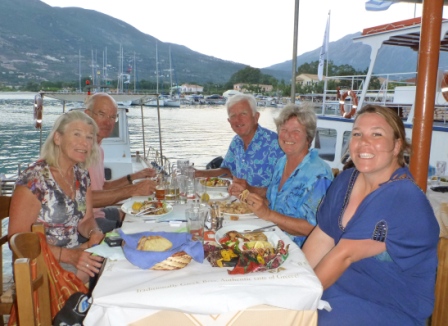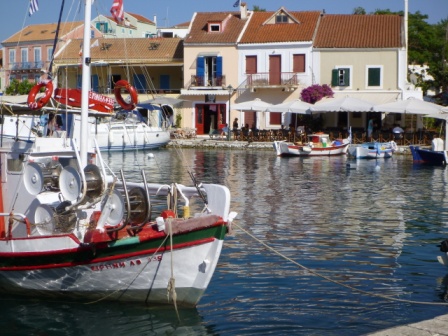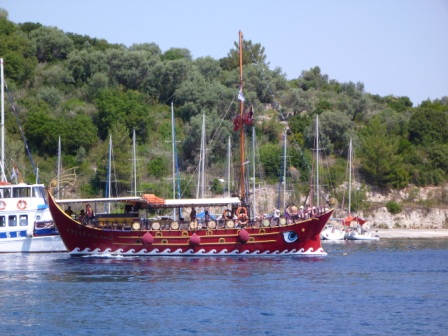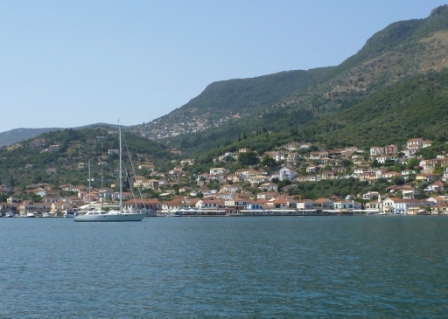HUNTING ULYSSES in Ithaka, Western Greece, July 2012, 37:47.60N 20:54.20E

|
HUNTING ULYSSES in Ithaka, Western Greece, July 2012, 37:47.60N 20:54.20E 8 June After an overnight sail from Montenegro we anchored in Erikoussa, Northernmost of the Greek Ionian islands, and started our summer in Greece, with David M and Maurits aboard. We checked into Greece at Corfu, and got our cruising Transit Log for 6 months. David left us from Corfu, and Maurits sailed with us south for another fortnight. In the meantime, he helped Roland to fit the new strip lights that Gilbert had given us, in the saloon and in the cockpit, these use so much less power. Maurits also made and fitted a Perspex cover over the engine control panel. We had several sails in the new Open Bic dinghy, which fits neatly on the deck behind the mast. Temperatures in the high 30sC with water temperatures of nearly 30’C meant we swam often in gorgeous clear water. On Corfu island we went to Ay Stefanos, and then north around the top of Corfu to Palaiokastrita, where Nausicaa brought Ulysses home to her father’s palace, after finding him naked on a beach. We sailed across to Paxos, and stopped at Lakka, Longos, and Gaios, ancient harbours. We met other cruising yachts from NZ, UK, Australia and Sweden, a change from Croatia, where most other yachts were chartered. We motored across to Emerald Bay at Antipaxos, a famous and crowded beauty spot. We motorsailed 30 nmiles from Antipaxos to the Levkas canal, originally dug more than 2,800 years ago, but destroyed by earthquakes and rebuilt. Many settlements across Greece were destroyed by earthquakes, one in 1953, some did not recover, and we saw many ruins. We sailed to bays on Meganisi island: Varko, Palairos, Ambelaki, Port Atheni, and to Skorpios island, famous for being the Onassis’ private island. We motored back to Levkas, which is a convenient place for a crew-change, with buses to Athens, huge town docks, fuel and supermarkets. Maurits left us by bus from Levkas. We met up with kiwi friends June and Pat on ‘Antares’ and together we hired a car and drove around Levkas island, at one stage up a mountain, we met a 100 year old local woman, who assured us Pat could squeeze the car up a narrow road, and at her age, she had seen it all, and was right! Near Preveza we saw Nikopoli, the ruins of where Anthony & Cleopatra loved (30BC), then went to see ‘Savarna’ in Cleopatra marina. Pat and Roland are sailing across the Atlantic with kiwi friends Pam and Keith, in the ARC in November, on ‘Savarna’.
28.6 Roland’s NZ cousin, Ollie and Paula with daughter Jacqui arrived in Levkas by bus from Athens for 10 days cruising together. We spent our days sailing, swimming, visiting tiny harbours, and having lazy lunches of Greek salad and Tzatziki or Taramasalata. We left Levkas for Kefali pt, Varko bay, Skorpios (our niece Jacqui swam to Jacqui O’s private beach house), then we went to Spartachori hilltop village and Vathi and Abeliki bays on Meganisi island. We sailed to Nisos on Kalamos island, Port Leone and Vasilikis (on Levkas again), Fiskardo on Kefalonia, Piso Aeto bay and Ag Andreas bay, on Ithaka, and lastly to Agia Efemia, Kefalonia (where Capt. Corelli was filmed). We had some fabulous meals of squid, cuttlefish, octopus, and Greek salad in some of the places we visited, people eat late and are often just starting their dinner at 9pm. It was a bit of a mission to find connections for their return to Athens, as some train, ferry, and bus services have been disrupted because of the economic situation and strikes, but they caught a bus which drove on to the ferry at 8:30am, from Sami on Kefalonia to Patras, where the same bus drove them over the Corinth canal bridge and by 4pm Ollie, Paula and Jacqui were by a hotel pool in Athens. Now just the 2 of us, we set off for Ithaka, legendary home of Ulysses. It seems that archae-ologists are finding more and more signs that there is truth behind the legend, although Ulysses lived some 3,250+ years ago. He was supposed to have taken 12 triremes with him to the Trojan War. We anchored in Vathi bay, under Mt Aetos, on the slopes of which archae-ologists have found a buried city that had been there since 1400 BC. Together with June and Pat we took a taxi ride up the mountains of Ithaka, to Stavros and Pelikata, other possible sites of Ulysses Palace. Who knows, maybe we walked where Ulysses had walked? 9 July Pam and Keith sailed ‘Savarna’ from Previza to Ithaka to meet up with us and ‘Antares’ with June and Pat on board, and together we had a lovely celebratory dinner, 3 kiwi boats in Ithaka! The next morning we all sailed off in different directions, we headed south to Zante, and had a wonderful 30nmile sail.
11 July Keir and his son Alasdair arrive from Scotland at Zante, on Zakynthos island, and we plan to sail round the bottom of the Peloponnese to Poros, where C’s Dutch cousin Mia lives. Olivia may have a few days holiday and join us in Poros, and on 15 August Feyona and Andre arrive from Sydney for a month with us, sailing from Greece to Turkey.***
Copied from “The Battle of Salamis” by Barry Strauss, book given to us by Oliver. “’Triremes’ refers to 3 levels of rowers. They were sleek ships. A Greek trireme was about 130ft long and about 18ft wide and sat about 8.5 ft above the waterline...The prow was tipped with a ram, a squat wooden structure encased in bronze and armed with 3 cutting blades in the fore. The ram sat on the waterline and extended about 7 ft off the stem. (When we sailed to Greece on ‘Reverie’ we saw a reproduction Trireme with a boar’s head ram – Consie) ….It is estimated that a Greek trireme under oar would normally travel at a speed of 5 or 6 nmiles per hour…. For short bursts of speed, for example during battle, it is estimated that the rowers could move a trireme at a rate of 9 or 10 nmiles per hour…….. In Athens… a trireme usually contained a crew of 200: 170 oarsmen, 10 marines, and 4 archers, as well as various seamen and petty officers, including the rowing master, the purser, the bow officer, the shipwright, the piper, and men to work the sails. Each trireme had a captain (in Athens called the trierach)… Oarsmen were unarmed. They probably had no uniforms and, in the hot, relatively airless space below decks, often wore only a loincloth. Archers carried bows and arrows, while Greek marines wore bronze helmets and breastplates, carried large, round shields, and fought with javelins and swords….. Since triremes, under battle conditions, were powered by human beings, victory depended in large part on training and toughening the men, on giving them plenty of food (salt fish and barley groats were staples), water (an estimated 1.85 gallons per man per day), and rest on shore (commonly at midday and at night). …. Every trireme depicted on its prow a pair of eyes and a name….” Do you think any of the triremes were ever called ‘Restless’?
|
